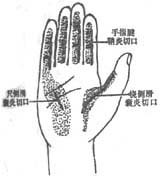| disease | Acute Suppurative Tenosynovitis |
Tenosynovitis of the hand is often caused by deep puncture wound infections, or it can occur due to the spread of infection from nearby tissues. The causative bacteria are mostly Staphylococcus aureus. Infections of the extensor tendon sheaths on the back of the hand are rare.
bubble_chart Clinical Manifestations
The condition progresses rapidly, and within 24 hours, pain and local inflammatory reactions become significantly noticeable. The typical signs of tenosynovitis are:
- The affected finger, except for the distal phalanx, shows obvious uniform swelling with extremely tight skin.
- All joints of the affected finger exhibit grade I flexion, often resting in a relaxed position of the tendon sheath to alleviate pain.
- Any slight passive extension of the finger can cause severe pain.
- Upon examination, tenderness is present along the entire tendon sheath. The suppurative inflammation is confined within the tough sheath, so no fluctuation is detected.
Infections of the ulnar and radial bursae are often caused by tenosynovitis of the little finger and thumb, respectively.
- Ulnar bursa infection: tenderness in the hypothenar region and the tendon sheath area of the little finger, especially pronounced at the junction of the hypothenar eminence and the palmar crease. The little finger and ring finger are in a semi-flexed position, and attempting to extend them causes severe pain.
- Radial bursa infection: swelling of the thumb, slight flexion, inability to abduct and extend, with tenderness in the thumb and thenar region.
- The affected area shows obvious swelling, severe pain, and significant tenderness along the tendon sheath.
- The affected finger is in a semi-flexed position, and pain worsens with finger extension.
- It is often accompanied by infection of the bursa and interstitium.
- Systemic symptoms such as fever and headache may also be present.
bubble_chart Treatment Measures
Early treatment is the same as for suppurative finger inflammation. If there is no improvement despite active treatment, early incision and decompression should be performed to prevent tendon necrosis.
Make a long incision on the side of the finger, parallel to the long axis of the finger. Do not make an incision in the center of the palm, as this can easily cause the tendon to protrude, leading to adhesions and skin scar contracture, which can affect the extension of the affected finger. During surgery, carefully identify the tendon sheath to avoid damaging blood vessels and nerves. In cases of infection of the ulnar and radial bursae, make incisions at the hypothenar and thenar eminences, respectively (Figure 1). The proximal end of the incision should be at least 1.5 cm away from the wrist to avoid cutting the branches of the median nerve. Another method is to make two small incisions on the tendon sheath and bursa to drain the pus, then insert fine plastic tubes for irrigation. Postoperatively, continuously drip antibiotic solution through one fine plastic tube, while the other serves as a channel for draining fluid. This method is more effective and causes less pain for the patient.

(1) Incision for suppurative tenosynovitis of the index finger and thenar space infection

(2) Incision for suppurative tenosynovitis of the finger, ulnar bursitis, and radial bursitis

(3) Incision for midpalmar space infection and thenar space infection
Figure 1: Surgical incisions for flexor tenosynovitis, bursitis, and deep palmar space infections of the hand.






